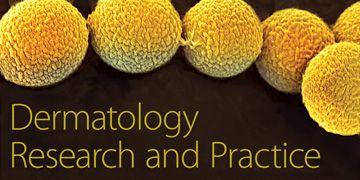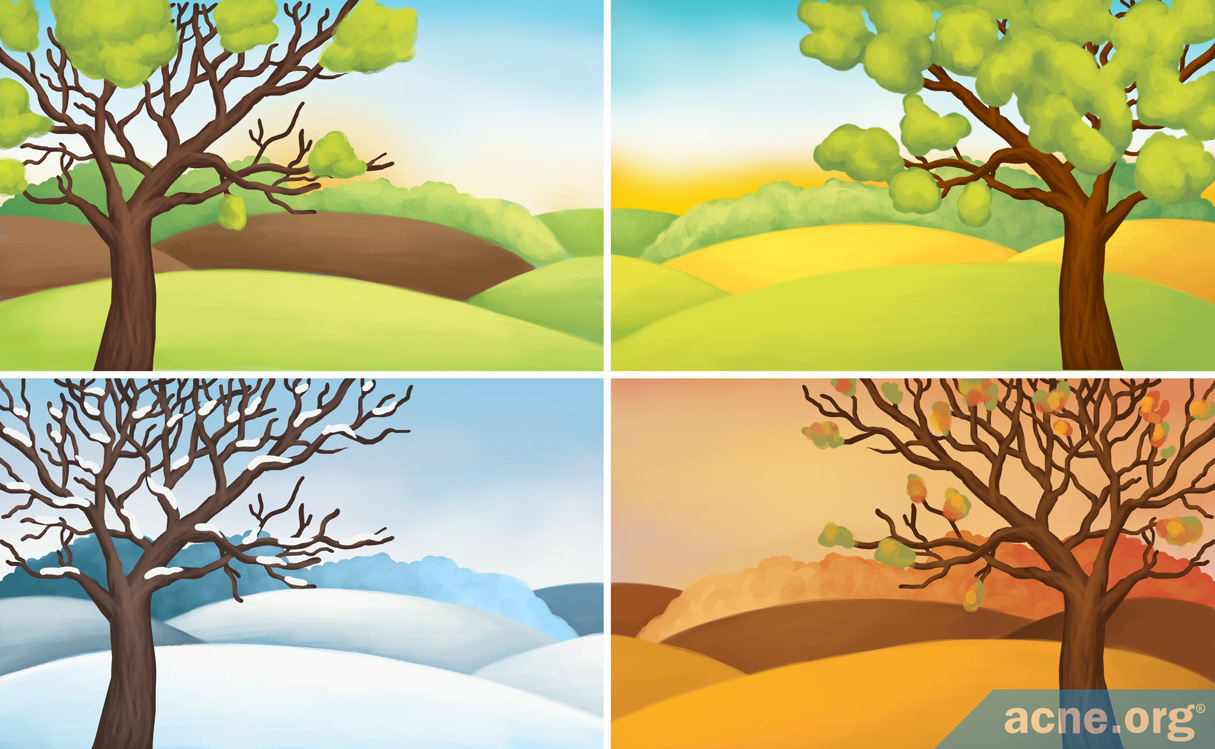Views: 1
Evidence Is Conflicting and We Simply Cannot Say

The Essential Info
Researchers have performed over a dozen studies that look at which season is worst for acne. The results of these studies are conflicting, and the answer is not yet definitive.
- Some studies show acne worsening in the summer
- Some show acne worsening in the winter
- Some studies show no seasonal pattern
Sometimes this is how it goes in science. We just have to wait for more evidence to trickle in. Read the full article below if you’re curious about the hypotheses that scientists have put forward for why acne might worsen in the summer or the winter. But keep in mind as you read that nobody knows the real answer to this question.

The Science
- Study Limitations Make It Hard to Draw a Conclusion
- Why Acne Might Worsen During Summer
- Why Acne Might Improve During Winter
- Arguments Why Acne Might Improve During Summer
- Conclusion
Study results on what season tends to coincide with more acne are evenly split across a few possible answers:
- 5 studies conclude that acne worsens during summer and improves in the winter1-5
- 5 studies conclude the opposite–that acne worsens during winter and improves in the summer6-10
- 5 studies conclude that there is no association between seasons and acne11-15
So, as we can see, it’s far too early to confidently confirm any answer to which season is worst for acne.
Expand to read details of studies that show that acne may worsen in the summer

A 1980 study published in Cutaneous Medicine for the Practitioner that examined seasonal differences in acne severity showed that three percent of acne patients’ symptoms worsened during the summer months. The researchers hypothesized that this was likely due to increased sun exposure, although they did not provide a scientific mechanism that would explain this hypothesis.1

A 2002 study published in The Journal of Dermatology looked at seasonal variation in 452 acne patients. The researchers found that 56.3% experienced worsening of their acne in the summer, compared to 16.2% seeing improvement in the summer and 11.4% seeing worsening in the winter. Most patients believed that the increased temperature, humidity, and sweating in the summer was behind a summer increase in acne.2

A 2009 study published in the Indian Journal of Dermatology examined the relationship between acne and seasonal changes in 309 Indian acne patients. The researchers found that 80 patients experienced seasonal worsening of acne, with a large majority of 71 of those patients’ acne worsening during the summer months.3

A 2016 study published in Dermatology Research and Practice examined the prevalence of skin diseases in 23,922 Nepali patients visiting a single hospital. The researchers found that patients reported acne more during the summer season.4

A 2019 study published in the Journal of Cosmetic Dermatology looked at seasonal variation in acne in India’s tropical climate. The study included 171 patients, 48% of whom reported seasonal variation in their acne. Among the Indian patients who experienced seasonal changes in acne, 84% reported worse acne in the summer.5
Expand to read details of studies that show that acne may worsen in the winter

In a 1975 British Medical Journal editorial a doctor proposed that acne would improve during the summer months because UV radiation may improve acne symptoms. However, this proposal was based solely on observations and had not been scientifically examined at the time.6

A 2002 study published in the International Journal of Dermatology examined skin diseases of 220 Saudi Arabian patients who visited a dermatologist over the course of a year. The researchers found that acne worsened during winter months but improved during the summer months, with one fifth of all patients visiting the dermatologists reporting acne. However, confounding factors like age prevented the researchers from identifying if the winter season was the sole cause of acne worsening.7

A 2008 study published in the Journal of Dermatology examined the skin diseases of 6300 Turkish pediatric patients, aged 0 – 16, who were admitted to the hospital between 2004 and 2006. The researchers found that acne was the most common skin disease in these patients. Additionally, the researchers reported that more patients with acne were admitted to the hospital during the winter season.8

A 2015 study published in the Journal of the American Academy of Dermatology examined the acne severity of 9301 patients in the Northeastern United States for three years to determine if seasonal changes made acne more severe. The researchers found that acne worsened during winter and improved in the summer.9

A 2021 study published in the International Journal of Women’s Dermatology looked at how often people in Iran visited a dermatologist for their acne during each season. The researchers found that from 2019 to 2020, 155 patients saw a dermatologist for their acne in the winter, compared to 94 patients in the spring, 109 in the summer, and 98 in the fall. Therefore, the scientists concluded that winter might be the worst season for acne patients. They wrote, “Acne…showed a significant seasonal peak in winter.”10
Expand to read details of studies that show no association between seasons and acne

A 1996 study published in the International Journal of Dermatology interviewed 139 patients to determine which season the participants believed worsened their acne. One third of patients reported their acne worsening during winter; one third reported their acne worsening in the summer, and one third reported no worsening during any season.11

A 2008 study published in the journal Clinics of Dermatology examined 3931 acne patients to determine if the season in which a patient received acne treatment affected the potency of the treatment. The researchers found retinoid treatments and antibiotics were more effective in clearing acne during the winter months when compared to summer. Although these findings are intriguing, the scientists did not observe any correlation between acne severity and season.12

A 2009 study published in the Journal of Investigative Dermatology examined the prevalence of acne in 1002 Iranian high school students. The researchers concluded that there was no correlation between season and acne severity.13

A 2015 study published in the Journal of Drugs in Dermatology examined the skin health of 17 New Jersey adolescents for one year to identify if skin properties like sebum (skin oil) production, moisture content, and acne changed with the seasons. The researchers found that the participants’ skin produced less sebum and decreased in moisture content during winter when compared to other seasons. However, the researchers did not observe any changes in acne severity over the course of the year.14

A 2016 study published in the International Journal of Dermatology analyzed the data from 700 patient records from a rural Yemeni health clinic to identify the number and types of skin disorders during the winter months. The researchers found that only eight percent of all skin diseases in these patients involved acne but were not able to determine if the season affected acne severity.15
Study Limitations Make It Hard to Draw a Conclusion
The various studies listed above used participants with different genders, ages, and geographical locations. This variety makes it impossible to effectively compare the research in order to draw conclusions about which season is worst for acne. Therefore, we will need more carefully controlled research with what is called a “standard research population” in order to determine if acne worsens during a particular season.
If acne does in fact get worse in the summer or winter, why might this be so? Let’s start with arguments why acne might worsen during summer and improve during winter.
Why Acne Might Worsen During Summer
Summer tends to bring higher temperatures and increased humidity, so these are the two main suspects. Specifically, scientists speculate that humidity might increase acne by:
- Bacterial imbalance: Humidity might disturb the balance of bacteria in the skin, allowing acne bacteria to overgrow and making breakouts more likely.
- A weaker skin barrier: The skin barrier is the outer layer of skin which protects the deeper layers of skin from damage. Some evidence hints that humidity might weaken the barrier, making the skin more prone to breakouts.
- More sweat: When the air is humid, sweat evaporates more slowly and ends up staying on the skin. Although sweat by itself doesn’t cause acne, if your skin is already physically irritated (such as from rubbing or scratching), sweat can make this worse and potentially trigger more acne.16-19
- More chance of sunburn: The summer sun can cause sunburn unless the skin is properly protected with sunscreen or clothing. Sunburn is a type of skin irritation, and as the skin heals up from a burn, it often bites back with acne breakouts.
Why Acne Might Improve During Winter
Winter is typically a time of lower air temperatures, lower humidity, and less intense sunshine (although this will depend on your geographical location). Therefore, we might expect the opposite effects on the skin from what we see in the summer:
- Less bacterial imbalance: A balance of skin bacteria means that acne bacteria don’t have a chance to overgrow.
- A stronger skin barrier: A healthy skin barrier means the skin is less prone to breakouts.
- Less sweat: While sweat itself is not an acne trigger, sweat combined with skin irritation can spell more acne. Therefore, less sweating might potentially mean fewer breakouts as well.
- Less chance of sunburn: As we have seen, a sunburn leaves the skin irritated and susceptible to breakouts, so the less likely a sunburn is, the better for acne-prone skin.
_____
However, as we have seen, some research finds the opposite, that acne might actually worsen in the winter and improve in the summer. Next, let’s look at the arguments why acne might worsen during winter and improve during summer. As you will see, there are still some puzzling inconsistencies.
Why Acne Might Worsen During Winter
- Skin hydration: To identify what might be the culprit in winter acne, scientists performed four studies between 2014 and 2015 and concluded that it may stem from changes in skin hydration. More specifically, patients in all four studies experienced a decrease in skin hydration during the winter season. Skin hydration is crucial for maintaining the healthy skin barrier, which is important in managing acne.14,20-23
- A weaker skin barrier: Additional research on the skin barrier function during winter has found one particular component of the skin barrier called ceramides, which can affect acne severity. Ceramides are found within skin cells and support the skin barrier function. Research has identified that acne patients typically possess lower levels of ceramides than patients with healthy skin, and that the levels of ceramides decrease during the winter season. In addition, research has shown that inside clogged pores is an imbalance of ceramides and other fats. This has led scientists to believe that a decrease in ceramides may partly explain the observation that in some people, acne worsens during the winter season.24-29
Arguments Why Acne Might Improve During Summer
Scientists have concluded in four separate studies that the UV radiation from the sun may explain acne clearing in some people during the summer months, specifically by:
- Decreasing inflammation: Research has shown that UV radiation may act as an anti-inflammatory agent. As inflammation is a major contributing factor to acne development, the researchers believe that UV light may decrease inflammation and help clear acne.
- Decreased acne bacteria: Additional research has shown that UV light may also help to reduce levels of the bacteria associated with acne called C. acnes.
The combination of anti-inflammatory light and a reduction in C. acnes could explain the observations that acne sometimes clears during the summer season. However, we will need more research to confirm these preliminary findings.1,6,28-31
Conclusion
There is not yet enough evidence to support the idea that acne worsens during a particular season. Scientists will need to perform more rigorous and controlled research before we can conclude anything definitively.
References
- Allen, H. B. & LoPresti, P. J. Acne vulgaris aggravated by sunlight. Cutis 26, 254 – 6 (1980). https://www.ncbi.nlm.nih.gov/pubmed/6448731
- Sardana, K., Sharma, R. C. & Sarkar, R. Seasonal variation in acne vulgaris–myth or reality. J Dermatol. 29, 484‐488 (2002). https://pubmed.ncbi.nlm.nih.gov/12227481/
- Adityan, B. & Thappa, D. M. Profile of acne vulgaris–a hospital-based study from South India. Indian J Dermatol Venereol Leprol 75, 272 – 8 (2009). https://www.ncbi.nlm.nih.gov/pubmed/19439880
- Poudyal, Y., Ranjit, A., Pathak, S. & Chaudhary, N. Pattern of pediatric dermatoses in a tertiary care hospital of Western Nepal. Dermatol Res Pract 2016 (2016). https://www.ncbi.nlm.nih.gov/pubmed/27247564
- Narang, I., Sardana, K., Bajpai, R. & Garg, V. K. Seasonal aggravation of acne in summers and the effect of temperature and humidity in a study in a tropical setting. J Cosmet Dermatol. 18, 1098‐1104 (2019). https://pubmed.ncbi.nlm.nih.gov/30238598/
- Editorial: Summer acne. Br Med J 4, 125 (1975). https://www.ncbi.nlm.nih.gov/pmc/articles/PMC1674867/
- Al-Ameer, A. M. & Al-Akloby, O. M. Demographic features and seasonal variations in patients with acne vulgaris in Saudi Arabia: a hospital-based study. Int J Dermatol 41, 870 – 1 (2002). https://www.ncbi.nlm.nih.gov/pubmed/12492972
- Tamer, E., Ilhan, M. N., Polat, M., Lenk, N. & Alli, N. Prevalence of skin diseases among pediatric patients in Turkey. J Dermatol 35, 413 – 8 (2008). https://www.ncbi.nlm.nih.gov/pubmed/18705828
- Pascoe, V. L. & Kimball, A. B. Seasonal variation of acne and psoriasis: A 3-year study using the Physician Global Assessment severity scale. Journal of the American Academy of Dermatology 73, 523 – 5 (2015). https://www.jaad.org/article/S0190-9622(15)01740-5/fulltext
- Khodaei, B., Seyedpour, S., Gholami, B., Garmarudi, G. & Nasimi, M. Seasonal and gender variation in skin disease: A cross-sectional study of 3120 patients at Razi hospital. Int J Womens Dermatol 7, 799-802 (2021). https://pubmed.ncbi.nlm.nih.gov/35028385/
- Gfesser, M. & Worret, W. I. Seasonal variations in the severity of acne vulgaris. Int J Dermatol 35, 116 – 7 (1996). https://www.ncbi.nlm.nih.gov/pubmed/8850040
- Weiss, S. C., Rowell, R. & Krochmal, L. Impact of seasonality on conducting clinical studies in dermatology. Clin Dermatol 26, 565 – 9 (2008). https://www.ncbi.nlm.nih.gov/pubmed/18755376
- Ghodsi, S. Z., Orawa, H. & Zouboulis, C. C. Prevalence, severity, and severity risk factors of acne in high school pupils: a community-based study. J Investig Dermatol 129, 2136 – 41 (2009). https://www.ncbi.nlm.nih.gov/pubmed/19282841
- Meyer, K. et al. Evaluation of seasonal changes in facial skin with and without acne. J Drugs Dermatol 14, 593 – 601 (2015). https://www.ncbi.nlm.nih.gov/pubmed/26091385
- Al-Kamel, M. A. Spectrum of winter dermatoses in rural Yemen. Int J Dermatol 55, 512 – 7 (2016). https://www.ncbi.nlm.nih.gov/pubmed/26341716
- Grice, E. A. & Segre, J. A. The skin microbiome. Nature Rev Microbiol 9, 244 – 53 (2011). https://www.nature.com/articles/nrmicro2537?draft=collection
- Cao, Y. S. et al. [Facial Demodex infection among college students in Tangshan]. Zhongguo Ji Sheng Chong Xue Yu Ji Sheng Chong Bing Za Zhi 27, 271 – 3 (2009). https://www.ncbi.nlm.nih.gov/pubmed/19852374
- Suskind, R. R. Environment and the skin. Environ Health Perspect 20, 27 – 37 (1977). https://www.ncbi.nlm.nih.gov/pubmed/413711
- Wiechers, J. W. The barrier function of the skin in relation to percutaneous absorption of drugs. Pharm Weekbl Sci 11, 185 – 98 (1989). https://www.ncbi.nlm.nih.gov/pubmed/2694089
- Nam, G. W., Baek, J. H., Koh, J. S. & Hwang, J. K. The seasonal variation in skin hydration, sebum, scaliness, brightness and elasticity in Korean females. Skin Res Technol 21, 1 – 8 (2015). https://www.ncbi.nlm.nih.gov/pubmed/24528115
- Youn, S. W., Na, J. I., Choi, S. Y., Huh, C. H. & Park, K. C. Regional and seasonal variations in facial sebum secretions: a proposal for the definition of combination skin type. Skin Res Technol 11, 189 – 95 (2005). https://www.ncbi.nlm.nih.gov/pubmed/15998330
- Song, E. J. et al. A study on seasonal variation of skin parameters in Korean males. Int J Cosmet Sci 37, 92 – 7 (2015). https://www.ncbi.nlm.nih.gov/pubmed/25351787
- Wan, M. J. et al. Seasonal variability in the biophysical properties of forehead skin in women in Guangzhou City, China. Int J Dermatol 54, 1319 – 24 (2015). https://www.ncbi.nlm.nih.gov/pubmed/25557023
- Yamamoto, A., Takenouchi, K. & Ito, M. Impaired water barrier function in acne vulgaris. Arch Dermatol Res 287, 214 – 8 (1995). https://www.ncbi.nlm.nih.gov/pubmed/7763094
- Thiboutot, D. & Del Rosso, J. Q. Acne vulgaris and the epidermal barrier: Is acne vulgaris associated with inherent epidermal abnormalities that cause impairment of barrier functions? Do any topical acne therapies alter the structural and/or functional integrity of the epidermal barrier? J Clin Aesthet Dermatol 6, 18 – 24 (2013). https://www.ncbi.nlm.nih.gov/pubmed/23441236
- Rogers, J., Harding, C., Mayo, A., Banks, J. & Rawlings, A. Stratum corneum lipids: the effect of ageing and the seasons. Arch Dermatol Res 288, 765 – 70 (1996). https://www.ncbi.nlm.nih.gov/pubmed/8950457
- Conti, A., Rogers, J., Verdejo, P., Harding, C. R. & Rawlings, A. V. Seasonal influences on stratum corneum ceramide 1 fatty acids and the influence of topical essential fatty acids. Int J Cosmet Sci 18, 1 – 12 (1996). https://www.ncbi.nlm.nih.gov/pubmed/19245474
- Magin, P., Pond, D., Smith, W. & Watson, A. A systematic review of the evidence for ‘myths and misconceptions’ in acne management: diet, face-washing and sunlight. Fam Pract 22, 62 – 70 (2005). https://www.ncbi.nlm.nih.gov/pubmed/15644386
- Pappas, A., Kendall, A. C., Brownbridge, L. C., Batchvarova, N. & Nicolaou, A. Seasonal changes in epidermal ceramides are linked to impaired barrier function in acne patients. Exp Dermatol 27, 833-836 (2018). https://pubmed.ncbi.nlm.nih.gov/29356138/
- Lehmuskallio, E., Hassi, J. & Kettunen, P. The skin in the cold. Int J Circumpolar Health 61, 277 – 86 (2002). https://www.ncbi.nlm.nih.gov/pubmed/12369118
- Webster, G. F. Light and laser therapy for acne: sham or science? facts and controversies. Clin Dermatol 28, 31 – 3 (2010). https://www.ncbi.nlm.nih.gov/pubmed/20082947
The post Which Season Is Worst for Acne? appeared first on Acne.org.

